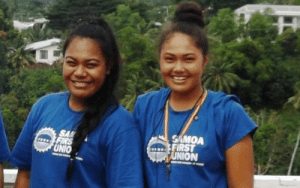5 Things about the status of women in the South Pacific

Students from the University of Samoa at the launch of Samoa First Union [Samoa First Union, July 2015]
In the lead up to International Women’s Day, we take a look at the status of women in the Pacific which covers a large area and has a diverse range of languages, cultures and races that are not homogenous.
Here are 5 Things you need to know about the status of women in the South Pacific!
1. Women’s Representation and Leadership is low
Women and girls comprise about half of the population in South Pacific Countries. However, the representation in leadership and decision making is very low. Statistics suggest that less than 14% of women are in parliamentary positions and the situation in the Pacific is the lowest in the world.[1]
2. Gender Inequality is High
Gender inequities in the South Pacific are stark. Women are vulnerable and at risk from violence, lack of economic opportunities and limited access to health care and education.[2]
3. Social and Cultural Structures Play a Role in Inequality
One of the main reasons for inequality comes from the traditional culture and social structure of each country. The capacity to achieve gender equality is not merely about changing laws, it is about social attitudes. Women are not regarded as equal and there is a struggle for women to face the challenges of both social and cultural complexities in each national setting.[3]
4. Paid Work: Men Outnumber Women 2-1
When it comes to paid work, men outnumber women by two to one. When agricultural work is excluded, there is no Pacific Country where more women than men are in paid work. If women had the same access to markets, credit and technology as men then the share of wealth for women would dramatically increase.[4]
5. Violence Against Women is an Ongoing Struggle and is often Condoned
Violence against women and girls is condoned by many cultures. Physical, sexual and emotional violence can be commonplace. Where laws exist to protect women, they are often not enforced or there is no capacity to access the remedies. There is a strong stigma to being a victim of these behaviours. Available figures suggest that up to 70 per cent of women (in Pacific Island Countries) face physical or sexual violence in their lives. There is little evidence that this experience of women has changed despite the implementation of aid and development programmes. This raises a question of the importance of including the status of women in the consideration of developing aid projects in the South Pacific.[5]
For further reading: http://asiapacific.unwomen.org/en/focus-areas/end-violence-against-women/evaw-facts-and-figures
REFERENCES
- [1] http://publications.dlprog.org/Womens_Leadership_Pacific.pdf
- [2] United Nations Women,”Women’s leadership and political participation
- http://www.unwomen.org/en/what-we-do/leadership-and-political-participation
- [3]Human Rights Issues confronting women and girls in the Pacific region; Submission by Secretariat of the Pacific Community Linda Petersen, Programme Manager, Human Development Programme Sandra Bernklau, Programme Manager Regional Rights Resource Team. https://www.aph.gov.au/DocumentStore.ashx?id=60640721-ce84-4fb3-b7a1-ebe175a27bbf&subId=253017
- [4] https://pacificwomen.org/our-work/focus-areas/economic-empowerment/
- [5] http://asiapacific.unwomen.org/en/focus-areas/end-violence-against-women/evaw-facts-and-figures